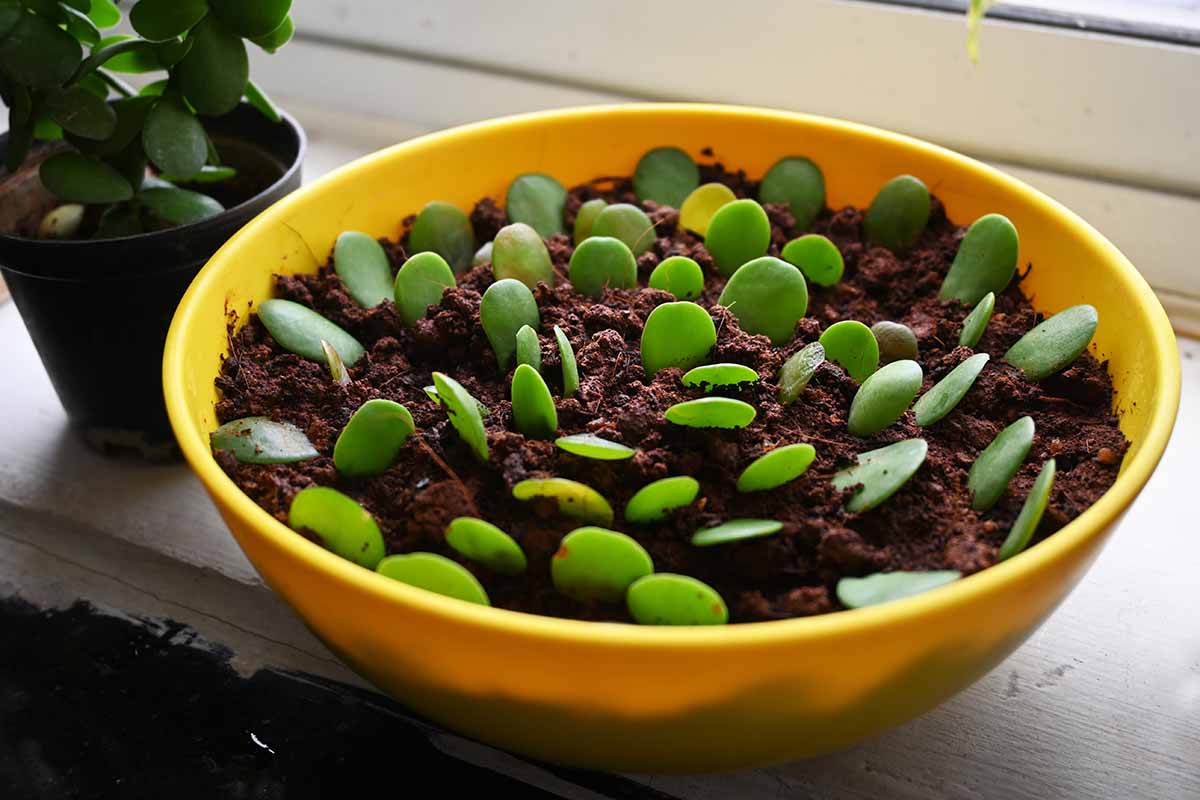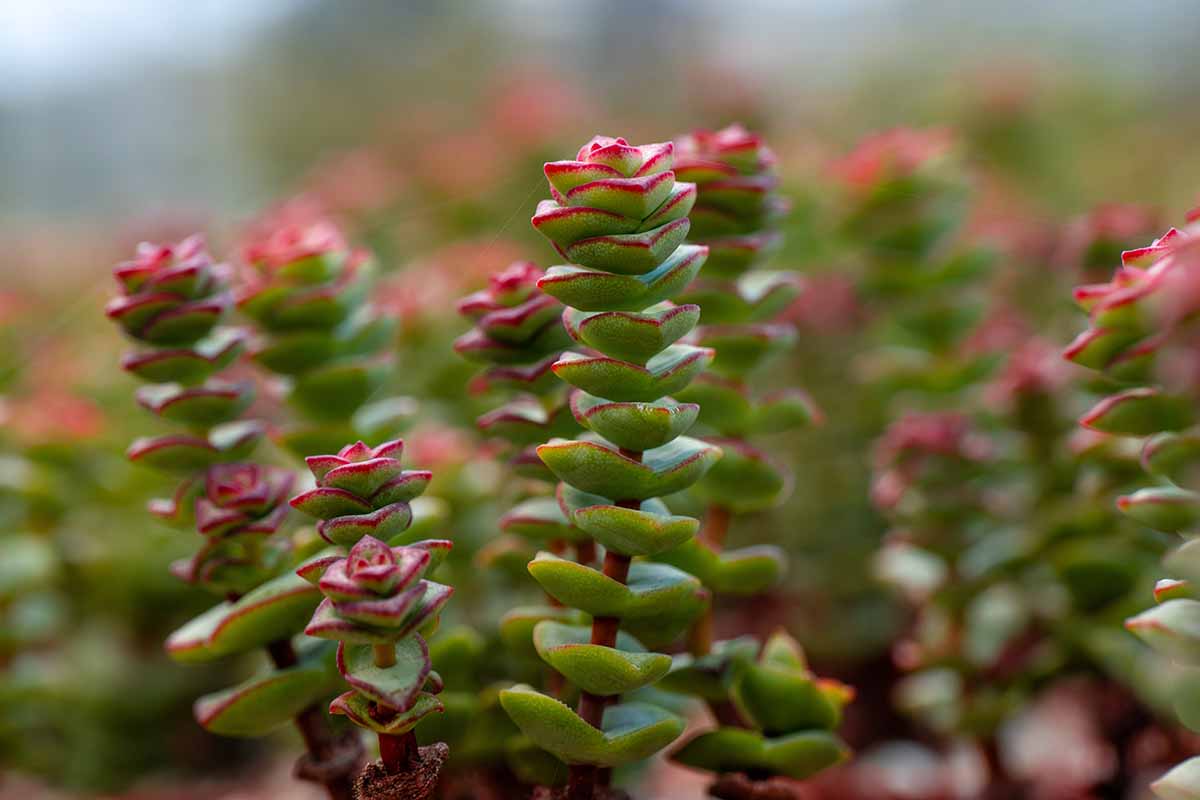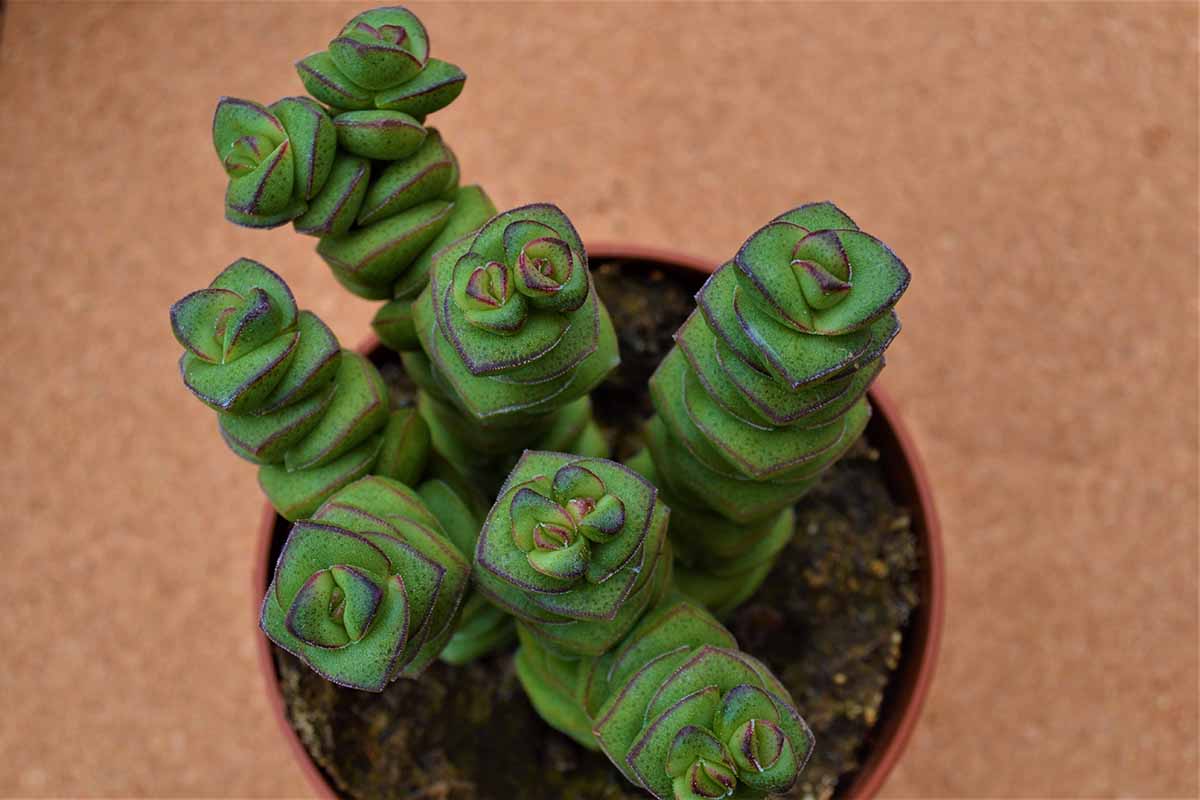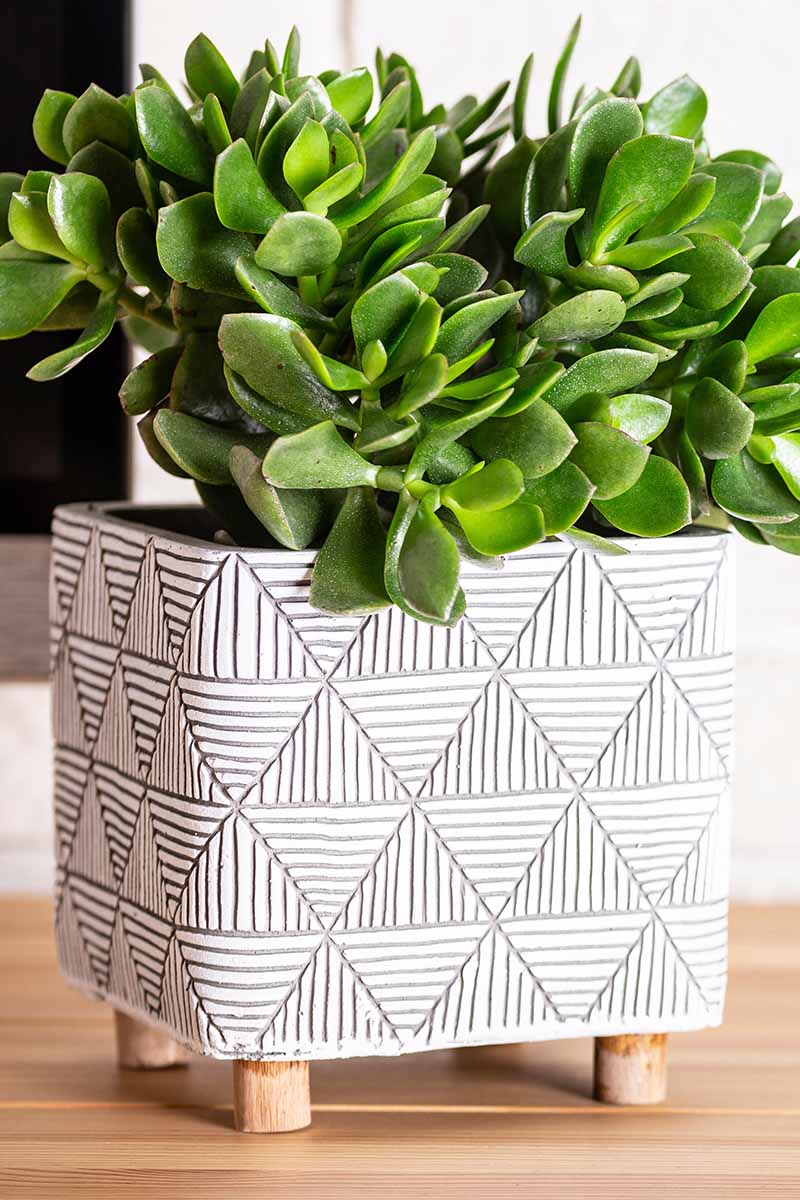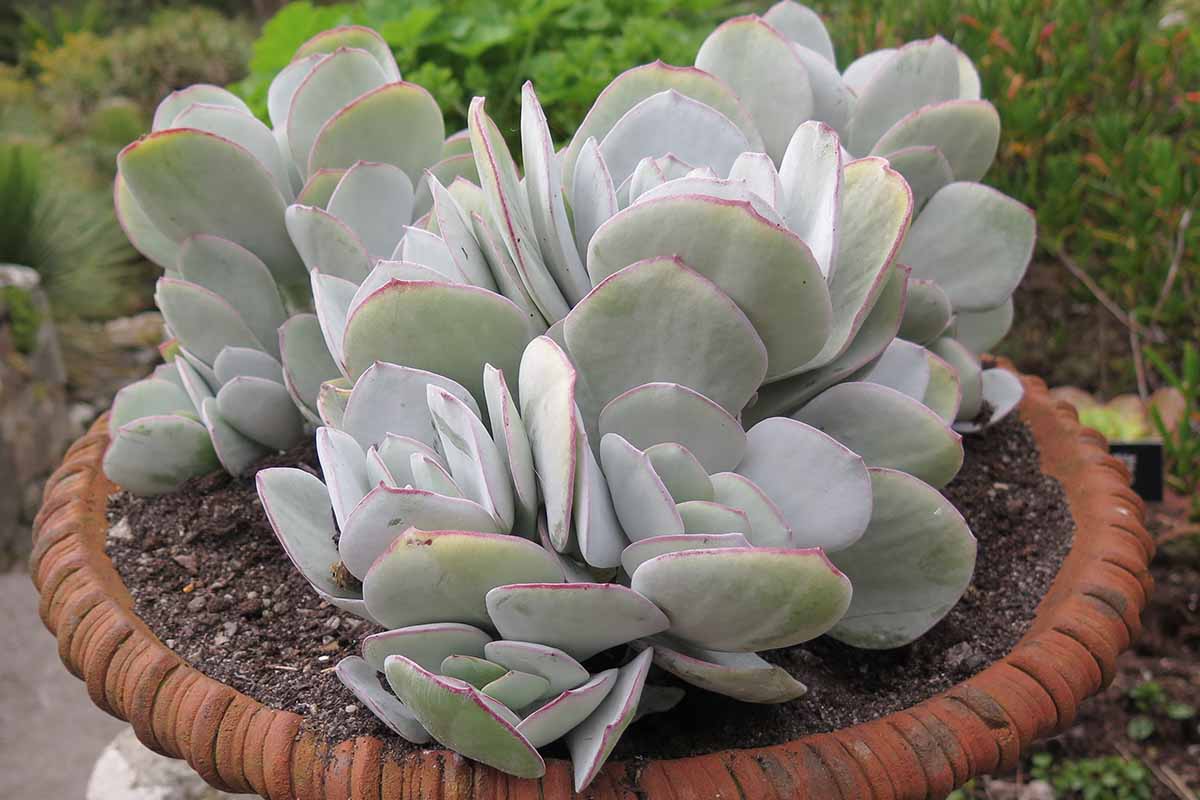We link to vendors to help you find relevant products. If you buy from one of our links, we may earn a commission. Those quirks give rise to common names for the various species like silver dollar plant, worm plant, jade necklace, and calico kitty. They share many traits and growing requirements, but they don’t often look that similar. I’ll introduce you to this intriguing genus and then let you decide for yourself which ones should make their way into your houseplant or Zone 11 to 12 outdoor perennial collection. Here’s what I’ll cover:
Cultivation and History
Native to South Africa, the species in the Crassula genus run the gamut from branching varieties like jade plants (C. ovata) to “stacked leaf” types like silver dollar (C. arborescens), to compact trailing types like jade necklace (C. marnieriana). Crassula means “thick” in Latin. It’s an apt name for this genus since all varieties produce fleshy leaves where they store water. Some varieties produce rosettes in various sizes and shapes, and they may feature a variety of colors, including white, pink, or magenta, in addition to bright green. In the wild or when grown as a perennial outdoors, jade can reach six feet tall and blooms with clusters of waxy flowers. Various other crassula species also bloom readily when grown outdoors, but the flowers aren’t as abundant as those of jade plants. Jade grows wild in thickets in the valleys in the Eastern Cape and KwaZulu-Natal provinces of South Africa, where its roots are often shredded and cooked for eating. Outside their native range, crassula succulents only grow as perennials in the hospitably warm areas of USDA Hardiness Zones 11 to 12. Happily for us indoor gardeners, they thrive as houseplants! Read on for an introduction to growing and caring for crassula, punctuated with lots of praise for its low-maintenance nature.
Propagation
The simplest way to propagate crassula is via cuttings. For the types that have a shrublike growth habit, simply take a stem cutting that’s a couple of inches long and root it in the soil. To root a cutting from a stacked-leaf variety, remove one of the lowest leaves and poke the end that was attached to the stem into the soil, plunging it half an inch deep. It’s not advisable to divide most mature crassula species for new starts. Jade is one type with a root system that becomes so entwined, you may end up losing both plants in the process if you try to separate them. But crassulas will sometimes produce “pups” or offsets near the base of the plant, and they’re fair game for digging up to propagate. Learn more about these methods in our guide to propagating succulents.
How to Grow
If you’re fortunate enough to live in an area where you can grow crassula outdoors, choose a full sun spot with afternoon shade and well-draining soil. You’ll also want to water outdoor specimens only once the soil has dried down to a depth of several inches. Use a soil moisture meter to make sure you’re not overwatering. Learn more about growing succulents outdoors in the garden in our guide. If you live in a cooler Zone, crassula can be grown as a houseplant. Follow these guidelines:
Containers
Be sure to choose a container with holes in the bottom to provide that all-important drainage that discourages death by root rot. Place saucers beneath pots indoors.
Soil
Fill each pot with a specialty cactus or succulent mix to about an inch below the rim, so the soil won’t wash out when you water your plants. Learn more about selecting the proper soil and container for your houseplant in our guide.
Placement
If you’d like to keep them outdoors for the spring and/or summer, place the plants in an area protected from wind since they can blow over easily, especially the branching shrub varieties like jade. They’ll need full sun, with protection from harsh afternoon rays. The ideal spot has morning sun and afternoon shade. Bring plants indoors when temperatures are expected to dip below 50°F. Inside, they will need a spot with bright light for at least six hours a day, and grow best in the 60 to 75°F temperature range. The same temperature and light requirements apply if you opt to grow crassula as a houseplant year-round.
Watering
Crassula doesn’t need a period of winter dormancy, but it doesn’t grow substantially in the fall or winter, so it’s a good idea to slow down on the watering then. Make sure the water drains completely each time, and discard any excess from the saucer. Succulents store water in their leaves, but when their roots get waterlogged for a prolonged period, they can develop root rot and must be trashed.
Growing Tips
Plant in well-draining soil.Outdoors, place in a full sun spot with afternoon shade.Provide bright light for at least six hours per day indoors.Let soil dry to a depth of several inches before watering.
Pruning and Maintenance
There are some types of crassula that can benefit from the occasional trim to maintain shape and promote healthy growth. This tactic also yields cuttings to root, and makes it possible to avoid the need for repotting plants that are spilling over the sides of their containers. Pups are also perfect for propagating, if they develop. But if you must, you can also pluck offsets from the soil and dispose of them in the compost to keep the plants from getting ungainly. Jade plants might benefit from some shaping, but they already “prune” themselves by dropping leaves from their lower extremities as they start to grow on vertical stalks and form their tree shapes. The other maintenance chore for crassula will entail repotting. But don’t rush it! Usually, they’ll need a new container just once every couple of years, and it should be only a size larger than the previous pot. For mature specimens, that interval can stretch to as many as five years, especially if you occasionally clip the stem ends on shrub varieties to keep them well-shaped and more compact.
Pests
Your eyes are the first line of defense in protecting crassula from bugs. Usually, if you see any of these insects before they’ve gotten a stronghold, you can eliminate them quickly. Here are a few of the most popular:
Gollum
A C. ovata cultivar like the more common jade trees, ‘Gollum’ is a shrubby succulent with distinctive tubular leaves that grow upright. The open ends look like suction cups and will develop bright red tips if they receive ample light. ‘Gollum’ Find ‘Gollum’ in four-inch pots available from Bumble Plants via Walmart.
Silver Dollar
C. aborescens, or silver dollar plants, are one of the larger crassula shrubs, able to grow four feet tall and spread a few feet, too. This species produces flat, silver, spoon-shaped leaves edged with maroon on thick, fleshy stems. You can expect clusters of pink or white flowers if you live in Zones 11 and 12, where silver dollar can be grown outdoors. Indoors, this silvery beauty rarely blooms. Silver Dollar Jade
Watch Chain
C. muscosa is also known commonly as rattail crassula. The stems are covered by tiny, overlapping, light green leaves and can grow to about 12 inches tall. As they get taller, the branches start to drape from pots, making this crassula a good option for hanging baskets. Watch Chain Watch chain plants are available in two-, four-, or six-inch pots from Succulents Depot via Walmart.
Managing Pests and Disease
One of the reasons crassula is so fun to grow is that it won’t usually incur pest infestations or sustain damage from common houseplant diseases. You should still watch out for these potential sources of harm, though:
Mealybugs
This insect from the Pseudococcidae family is singularly unappealing, with tiny little nymphs and adult females that look like crawling bits of, well, mucus. They lay eggs on the plants and feed on all parts of the crassula, worm their way into the soil, and secrete “honeydew” that sticks to the plant and encourages black sooty mold to form. Remove a small infestation of these sticky bugs with a cotton pad dipped in rubbing alcohol. For ways to handle a more widespread outbreak, read our mealybug guide.
Scale
Scale will also suck the life-sustaining sap from thick, fleshy crassula leaves. These are also bitty bugs, in white, brown, or gray. Wipe off just a few with the old rubbing-alcohol-dampened cotton ball trick, or use insecticidal soap or neem oil for more severe cases. More complete directions for preventing and eradicating scale can be found in our guide.
Spider Mites
These tiny arachnid sap-suckers cause leaves to yellow or develop brown spots that get larger and larger. The top preventive measure is dusting the leaves. And the first line of treatment is spraying the bugs off the plants with a steady stream of water from the hose or kitchen sink nozzle. Follow up with another blast a week later, and continue at regular intervals until you can no longer spot the mites or their webbing. For more persistent cases, try treating the plants with neem oil or a few drops of rosemary essential oil mixed with water in a spray bottle, and squirted on the foliage. Read more about controlling mites on succulents in our guide.
Diseases
Like most succulents, crassulas won’t have much trouble with houseplant diseases. The main one to watch out for is root rot, which you can discourage by planting in well-draining potting soil and ensuring you don’t overwater the plant, or let it sit in a saucer of drained water. Also be on the lookout for powdery mildew, which may look like a fine dusting of flour on the leaves but is actually the result of a fungus from the Erysiphe genus. If you’ve placed crassula in a humid spot, powdery mildew may emerge even if you’ve been careful not to let the soil get too soggy. You can remedy a light dusting with a washcloth moistened with water, but a more advanced case might require fungicide. To prevent and detect powdery mildew, check out our guide to home and commercial remedies.
Best Uses
Most crassula varieties make excellent houseplants for bright indoor spaces, especially if you’re looking for a plant that can cope with low humidity. They’re also lovely in small rock gardens, and the taller jade trees can serve as a focal point in a cluster of shorter houseplants. For my money, though, the best use for crassula is as a collectible succulent. Within this one genus are so many quirky, colorful varieties, each with the same growing requirements as the others but with vastly different appearances. Why not take the opportunity to grow several in a single bowl or window box, experimenting with the various colors, sizes, and rosette and leaf shapes that all can share an indoor gardening space? And since crassula is low maintenance, I’m able to sustain a wide range of these beauties without excessive effort on my part. I love that! Are you growing one or more types of crassula? Please share your experience, ideas, or questions in the comments section below. And if you’re interested in some other succulents that thrive with little care, read these guides next:
How to Grow and Care for Panda Plant IndoorsGrowing Hens and Chicks: How to Care for Sempervivum PlantsHow to Grow and Care for Haworthia Indoors




